I first got interested in sharpies after building an Arch Davis-designed Laughing Gull and sailing it for some 10 years. I became enamored with its speed and shallow draft. When I moved from Miami to New Orleans, I found that the best sailing here is during the cooler months, but it was hard to find crew willing to take spray on that 16′ open boat on chilly days. I needed a bigger boat, and I wanted it to be a sharpie.
When I discovered the Norwalk Islands Sharpie 23 (NIS 23), I knew that it was the one for me. The NIS class ranges from 18′ to 31′ and was designed by the late Bruce Kirby, who is best known for creating the globally popular Laser. He deemed his Sharpie-class boats “cruising Lasers for grown-ups.” Kirby’s sharpies are flat-bottomed, centerboard cat-ketches with unstayed masts. Prior to getting my hands on a Norwalk Islands Sharpie 23 for myself, I read an article by Robert Ayliffe, arguably the world’s foremost advocate for the class, in Australian Amateur Boat Builder in which he described crossing the treacherous Bass Strait in his NIS 23 and reaching 17.5 knots surfing down swells. The NIS 23 seemed like an affordable way to have a high-performance cruising boat, and I wanted to experience this speed for myself.
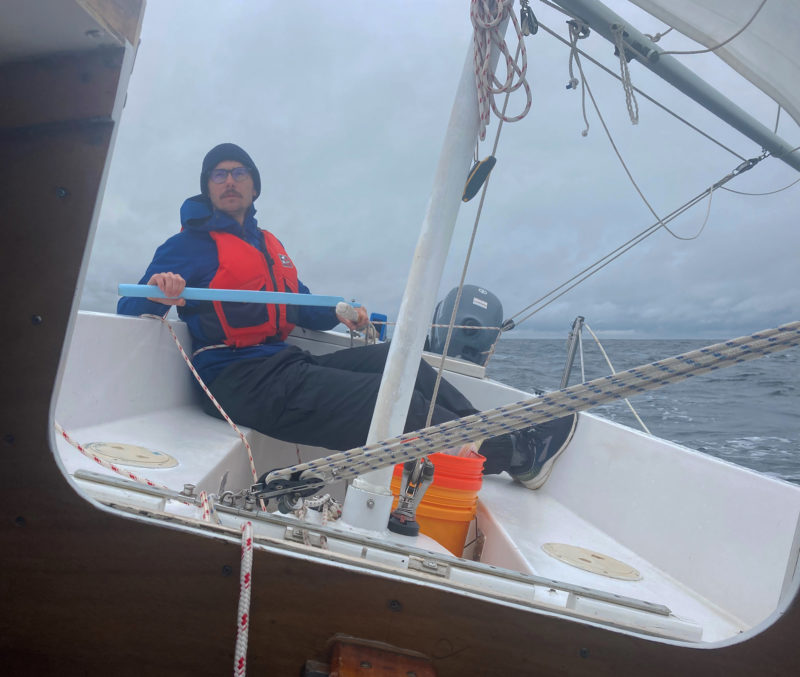 W. Peter Sawyer
W. Peter SawyerThe mainsheet is anchored to a traveler forward of the mizzenmast, and the mizzen’s sheet leads forward to the base of its mast. Both are within easy reach of the helm.
My NIS 23 was built in 1996 at Sea Island Boat Works in South Carolina, though many have built their Norwalk Islands Sharpies at home. The single-chine plywood hull is built over plywood frames and sheathed in one layer of epoxied fiberglass. Ballast is supplied by 2″ of lead that surrounds the centerboard slot on the bottom of the boat, reportedly weighing about 600 lbs. The centerboard is made of aluminum. The construction is solid, and I have felt secure in all conditions.
I keep my NIS 23 in the water, but it is easily trailered. Since it has a centerboard and flat bottom, it comes up on the bunks with no trouble at all. I have towed mine with a Honda Pilot, but I feel much safer on the road when it is behind a pickup truck.
Early versions of the Norwalk Islands Sharpies had aluminum masts; later ones, like mine, carry carbon-fiber ones. They’re stepped in tubes just as you would drop in a mast on a Laser. There are no stays. The mainmast can be stepped by just two people, who are always relieved when it is in—and not lying fractured on the pavement. Ayliffe has designed an optional tabernacle system that would greatly reduce the stress associated with getting the masts into place. Maintenance has been easy—with its simple cat-ketch rig, there is not much to keep up. Varnished wood is at a minimum. Getting the boat from highway and ready for sailing from the dock takes about an hour and a half.
The boat is tender at the dock. When welcoming guests on board, I always stand on the opposite side of the boat so their side does not settle in the water so much when they step in.
The cockpit is generous for a boat of this size, and four adults can sit comfortably forward of the tiller. When out for a sunset cruise carrying a conservative amount of sail, the cockpit remains comfortable even while heeling. If I’m looking to maximize speed, I release the lifelines and sit on the gunwales. A short hiking stick is needed. Visibility from the cockpit is excellent.
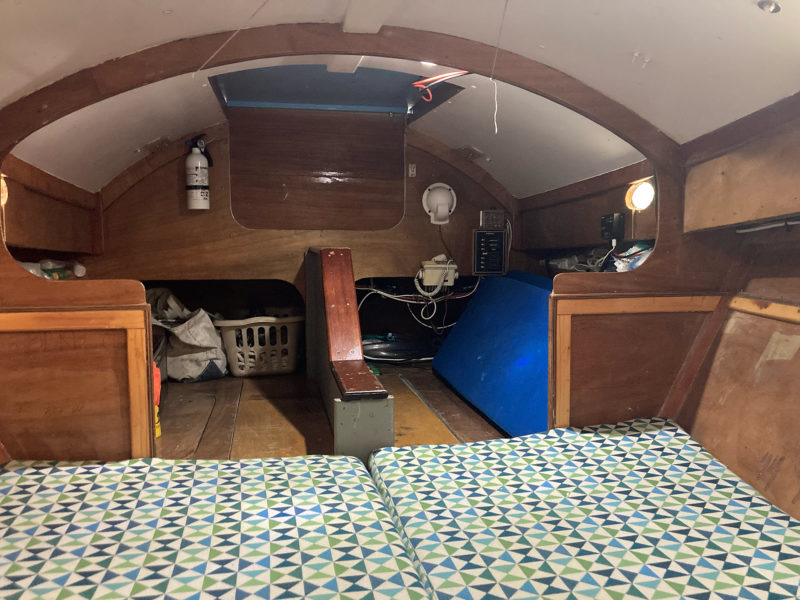 W. Peter Sawyer
W. Peter SawyerThe custom forward V-berth for two, here with cushions in place, is spacious and frees up the aft part of the cabin for storage. The berths flanking the centerboard trunk e have had the cushions of third and fourth berths removed to reveal the plywood panels that cover the footwells either side of the trunk.
Once underway, the NIS 23 is simple to sail. Being a cat-ketch, it does not carry a jib, but rather a main and mizzen. Both sheets can be managed by the skipper. Tacking involves merely pushing the tiller to the lee side of the boat. With no jib, no handling of sheets is required. I’ve had difficulty making it through irons only in winds above 20 knots and with a steep chop.
The NIS 23 carries plenty of sail, and I am quick to put in a reef if upwind sailing is required. I have two reefing points on the main and one on the mizzen. When the windward chine lifts from the water, it is time to reef. Most NIS have a reefing system that can be controlled from the cockpit. I’ve not taken the time to set it up on mine, but should.
The boat does not love to go upwind—it points to about 55 degrees off true wind and, in a chop, it needs another 10 degrees or so off to maintain boat speed. That said, the NIS 23 will make 5.5 to 6 knots on a closehaul in as little as 12 knots of wind.
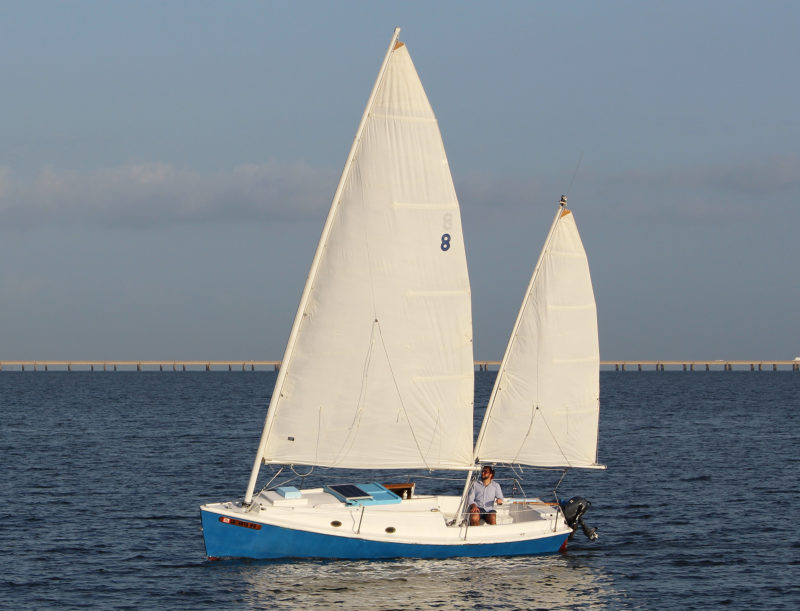 Emily Woodruff
Emily WoodruffThe NIS 23 carries a 150-sq-ft mainsail and a 64-sq-ft mizzen.
The boat shines on a beam reach to broad reach when it maintains 6.5 knots boat speed in about 12 knots of wind. It can carry considerably more sail downwind. Its maximum speed I’ve seen was 10.7 knots running a broad reach in 20 to 25 knots of wind with full sails up. It becomes easier to control the boat after coming up on plane, though she only stays on plane while surfing down a wave. When not on plane, the boat’s weather helm is an annoyance. This can be reduced by dropping the mizzen and reefing the main, though the thrill of getting on plane means I don’t use this option much downwind. However, in 30 knots of wind, I’ve made 10.4 knots with the mizzen alone (though the carbon-fiber mizzenmast was bent like a parenthesis).
If the wind is more than 15 knots, the NIS 23 likes being on a run, too; the cat-ketch sail plan makes running wing-on-wing straightforward. If the wind is less than 15 knots, trading broad reaches is faster and more enjoyable. I keep the centerboard down for stability while running downwind.
I’ve sailed the boat extensively on the north Gulf Coast, particularly in Mississippi Sound, in winds up to 40 knots. With two on board, it can continue sailing on all points of sail up to about 20 knots with a double-reefed main and single-reefed mizzen. Upwind, I drop the mizzen at 25 knots and sail with just the double-reefed main. Caught in a squall, alone, I had to go to bare masts when the winds pushed over 35 to 40 knots.
With its flat bottom and centerboard, the boat’s motion in heavier seas is surprisingly comfortable. There is none of the laborious lumbering that’s felt on keel boats.
The sharpie is stable under sail, and I’ve never worried about a capsize. However, it is quick to heel, making early reefing important. The carbon-fiber masts mitigate gusts by flexing and thus dumping excess wind, reducing heel. Crew can move about while underway, but not without being alert. This is particularly the case when sailing upwind.
Despite their flat bottoms and relatively high-placed ballast, the Norwalk Islands Sharpies are claimed to be self-righting. I have never felt remotely close to a knockdown in mine, even while carrying too much sail in high winds.
The mizzen is an excellent sail for maneuvering in the marina. After getting comfortable with how far the boat drifts, I rarely use the engine for anything but backing out of my slip. When returning, I drop the powerful main about 100 yards from the dock and then amble toward the slip under mizzen alone. The mizzen is easily doused while holding the tiller, and I do this about 10 to 40 yards from the slip, depending on the wind. We then glide into the dock, and I arrest the remaining motion by placing a hand on a piling.
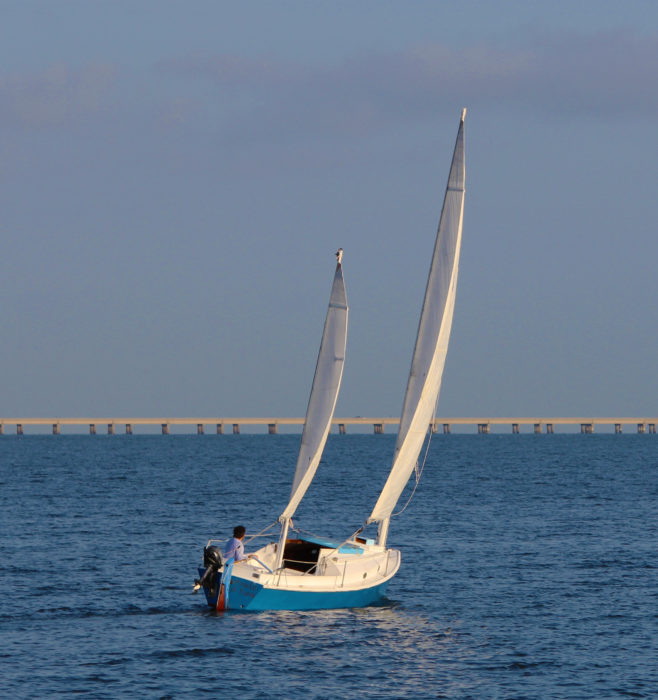 Emily Woodruff
Emily WoodruffThe aluminum centerboard and 600 lbs of interior lead ballast help the NIS 23 stand up in a breeze.
Overall, I rate the NIS23’s sailing performance as nothing short of thrilling on a beam reach or broad reach. She is fair upwind and strong on a run—as long as you have a stiff breeze. My favorite characteristics of the boat are its speed and the shallow draft that enables the exploration of marshes and flats.
I have a 6-hp outboard on a bracket off the stern, which is more than adequate. The boat doesn’t need more than half-throttle to reach hull speed, which is around 5.5 knots.
At anchor, the NIS23 is pleasant. I have so far spent about 45 nights on board and, while many have criticized sharpies for pounding at anchor, that has not been my experience. Its extremely shallow draft of just 8″ allows access to very protected anchorages inaccessible to deeper-draft boats. In my cruising grounds, marshes are abundant. My approach is to anchor just 50′ or so off the windward marshland or even in a narrow marsh creek.
One night while anchored off Cat Island, Mississippi, a large storm brought 45-knot winds. Despite my taking cover in a marsh creek, the winds whipped the boat back and forth at anchor all night, making sleep all but impossible. Around 3 a.m., I awoke, and while the wind roared, my berth was paradoxically motionless. Fearing that the anchor had dragged and the boat had been driven into the marsh, I peered out of the hatch. My headlamp illuminated black mud all around me. The wind had driven about 3′ of water out of the marsh and the boat was resting contentedly on its flat bottom. I slept well the rest of the night, and then had to wait about 8 hours for the water to come back.
Accommodations in the cabin are limited; I liken the experience of time spent in the cabin to a spacious, floating tent rather than a yacht. If your NIS 23 don’t have the curved-hatch option, which provides 5′ 11″ of headroom, don’t count on standing up. In the after part of the cabin, there are two full-length single berths; I removed part of the cabin’s forward bulkhead to allow for a V-berth for two more crewmembers. Kirby’s drawings have options for a similar arrangement of four berths as well as sleeping accommodations for two with open space for a galley and a head. I have three overhead lights and a ventilation fan powered by a solar panel/battery. For cooking, I bring along a Coleman stove and place it in front of the cabin hatch in the cockpit, which is a good arrangement even when it is raining. Even for a nine-day Gulf Coast cruise, there was plenty of space for provisions and enough sleeping area for two.
The Norwalk Islands Sharpie 23 is a simple, fast boat with exceptionally shallow draft. I bought mine after having done quite a bit of camp-cruising in a 16′ open boat, and while the NIS 23’s cabin is nothing fancy, it is quite nice to not have to worry about finding a campsite at the end of the day, just a protected spot of water. ![]()
Peter Sawyer is a general surgery resident in New Orleans, Louisiana. He learned to sail when he was 11 years old at Camp Sea Gull, a seafaring summer camp on the North Carolina coast. He has been at it ever since.
Norwalk Islands Sharpie 23 Particulars
[table]
Length/23′
Load waterline/18′ 9″
Beam/7′4″
Draft, board up /8″
Draft, board down/4′ 6″
Weight/1,540 lbs approx.
Sail area, main/150 sq ft
Sail area, mizzen/64 sq ft
Sail area, total/214 sq ft
Power, outboard/ 2 to 3.5 hp
[/table]
Plans for various arrangements for the NIS23 are available from Norwalk Islands Sharpie. Options include plans for a “from scratch” build, a precut “plywood only” kit, and an “everything you will ever need, including trailer” kit.
Is there a boat you’d like to know more about? Have you built one that you think other Small Boats Magazine readers would enjoy? Please email us!
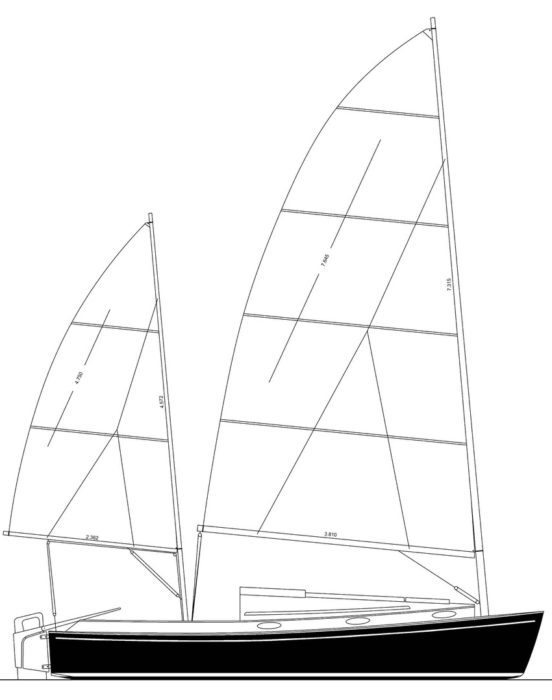
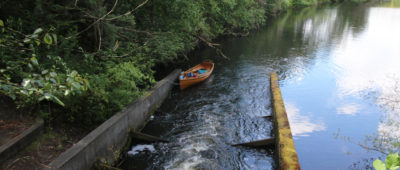
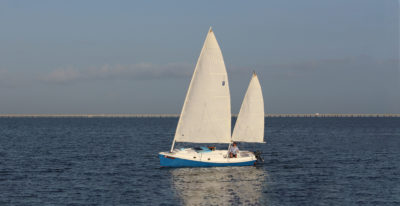
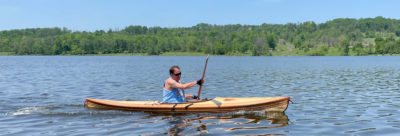
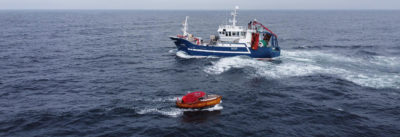
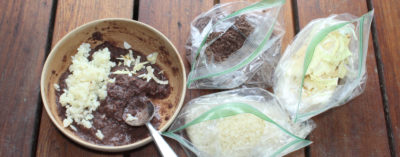
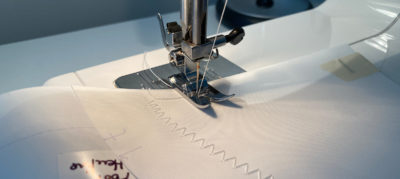
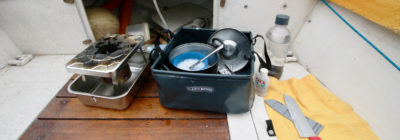
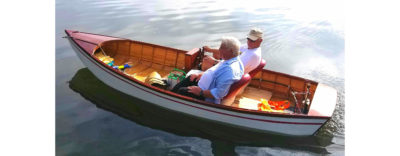
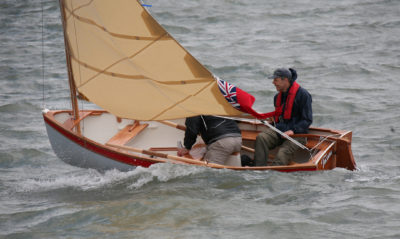
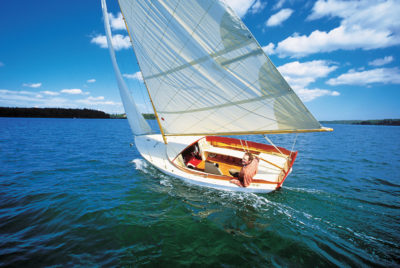
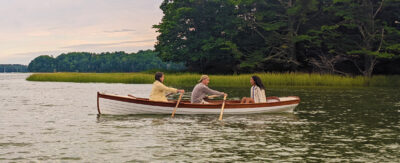
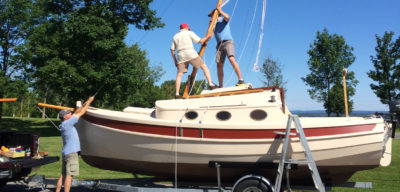
This might be just the thing for the bay side of the eastern shore on the Chesapeake. Am imagining runs from Onancock to Tangier.
I built one of the first 18′ NISs, cat rigged. The mast was fiberglass, built like a fishing pole-the diameter tapered, and the wall thickness also. It was built in Florida, and I had a heck of a time getting it to my shop here in Wellfleet. It arrived the day before the scheduled launch day, I had just enough time to put a coat of primer on it . We rigged and launched the boat, and the owner took the helm and sailed straight for Martha’s Vineyard, I never got a sail on the boat!
PS- The owner was very happy with the boat, enjoyed it for many years.
You may consider replacing the Aluminium centreboard with a proper foil, it can do a lot to improve pointing to wind.
Great article about a great boat.